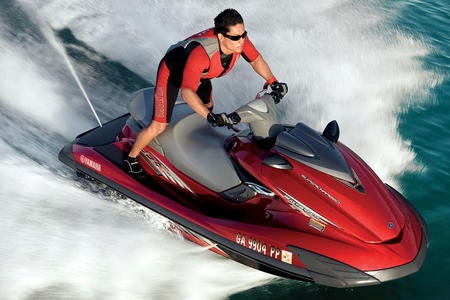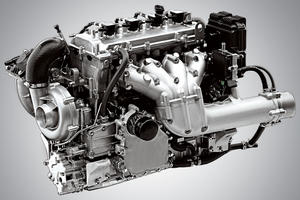2009 Yamaha FZS Review
Aggressive power and handling for the three-up crowd
Yamaha said goodbye to the long-running GP series this year. The boat’s aggressive, performance-minded spirit, however, lives on in the newly minted FZ models, the two-passenger FZR, and the subject of this review, the three-up FZS.
Something Old, Something New
While the FZS is an obvious attempt to capitalize on what was great about the GP line, it also displays characteristics in line with Yamaha’s other flagship models, the FX craft. In fact, overall dimensions are identical to the FX in both length and beam. Take a glance below, however, and you’ll note key differences. For one, the wetted area of the hull is shorter. The FX’s abrupt chines have also been softened into a rolled angle. The design loses some of the FX’s stability as a result, but gains a lean-in personality in the turns that aggressive riders should appreciate.
 The performance-minded GP Series may be gone, but Yamaha kept its spirit alive in the new FZ Series.
The performance-minded GP Series may be gone, but Yamaha kept its spirit alive in the new FZ Series.Other differences include a larger pump inlet, an obvious attempt to load the pump with more water for improved acceleration. That typically results in drag, so Yamaha added lifting strakes that run the full length of the hull. The FZ models also get the GP’s trademark dihedral keel design. The result is a boat that pretty effectively offers the aggressive ride of the GP series, but maintains Yamaha’s familiar rough-water handling and stability.
 The FZS features a three-position telescopic steering column.
The FZS features a three-position telescopic steering column.Now for the completely new. Yamaha research indicates that today’s performance sit-down rider still likes to stand. On most boats, that results in a bent-over posture that may or may not be all that comfortable over time. To address the situation, the company created a three-position, telescoping steering column that rises as much as 4” above the lowest setting. Stand on an FZS and the bars can rise with you. Sit and they can sink to a standard, or even ultra-low setting. I found that the telescoping steering worked in the up position; I was in fact more comfortable not bending over the bars. I really enjoyed the idea, however, in its lowest setting. On calm water, riders can drop the bars down and rail the FZS through a corner like a Superbike. The hull grips tenaciously, and just begs a rider to push the boat to its limits. It’s surprisingly fun, and arguably takes the best advantage of the hull design below. No, it won’t rival the WaveBlaster of old, but the FZS provides that aggressive cornering thrill that’s all too often lost on today’s bulkier three-ups.
And yes, this is a three-up. The S, rather than the R, indicates that difference. It’s little more than a change in design to the aft section of the seat and the addition of a grab bar, but the S proves roomier and likewise more comfortable. The S designation also gets you a legitimate tow eye for skiing, boarding, and tubing duty, as well as a spring-loaded boarding ladder.
Proven Power, Amenities
 Yamaha outfitted the FZS with its 1.8-liter supercharged engine.
Yamaha outfitted the FZS with its 1.8-liter supercharged engine.The FZS is a performance model, so Yamaha wisely chose the 1.8-liter supercharged engine that debuted on last year’s SHO flagship. It produces in excess of 200 hp (remember, Yamaha no longer publishes an exact figure), and gets the boat to a top speed of 66-68 mph, while galloping to a 0-30mph time of just under two seconds. Early reports claimed as quick as 1.5, but I’ve never seen that in any production boat I’ve tested.
The engine is the largest displacement powerplant currently in use industry-wide. Like on the SHO models, it allows the use of drive-by-wire throttle rather than the standard cable. Forget the cruise control, however. This is a fighter, not a lover.
The SHO’s NanoXcel hull material is also used, an alternative that achieves both light weight and strength through its unique method of bonding and filler. That’s a good thing. I’d give a more mixed reaction to the FZS’s continued use of Yamaha’s manual trim system. The idea is good – it allows you to adjust the trim position without ever taking your eyes off the water. At higher speeds, however, the rider is fighting to move the nozzle against the force of water exiting the pump, limiting the concept’s effectiveness.
As always, I found other items to praise, as well as persecute. I like Yamaha’s choice of large, analog gauges, trimmed in a sporty red. They fit the boat’s profile. I’m not so crazy about the severe slope to the aft deck area. The idea is it makes it easier to board. In reality, I stepped up from the boarding ladder, only to clumsily slip off due to the deck’s rearward angle. Other mixed reviews are given to the remote security system (it’s a cool key fob, but seems easy to misplace), and reverse (effective, but with an awkward starboard location for the lever). Storage, however, is decent at 21-plus gallons. And as always, I love the fact that all Yamahas are designed to run on basic 87-octane. In tough times, every penny counts.
Turn and Burn
My lasting impression of the FZS? A fun, ultra-aggressive boat, with a powerhouse engine and some of the best handling performance currently available.
It delivers the essence of what a personal watercraft originally set out to be.
| Yamaha WaveRunner FZS Specs | |
| Length | 132.7 inches |
| Beam | 48.4 inches |
| Curb Weight | 813 lbs |
| Engine | Four-cylinder DOHC EFI |
| Displacement | 1,812 cc |
| Bore and Stroke | 86mm x 78mm |
| Compression Ratio | 8.6:1 |
| Rated Horsepower | N/A |
| Fuel Capacity | 18.5 gal. |
| Combined Stowage Capacity | 21.3 gal. |
| Colors | Crimson Red Metallic; Jet Black |
| Price | $12,899 |
Related Reading
2009 Yamaha WaveRunner FZR Review
2009 Yamaha FX SHO/FX Cruiser SHO Review
2009 Yamaha WaveRunner Lineup
Get PersonalWatercraft.com in your Inbox!
Like PersonalWatercraft.com on Facebook
Comments
Most Popular

2025 Yamaha JetBlaster PRO 2-Up Review

2024 Kawasaki Jet Ski STX 160X Review

Remembering the Sea-Doo XP

Whatever Happened to the Wetbike?

2025 Yamaha JetBlaster Review














 Your Privacy Choices
Your Privacy Choices